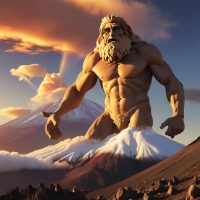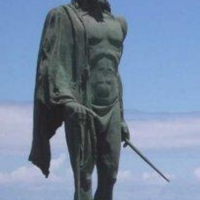Achaman : The Creator God
Listen
At a glance
| Description | |
|---|---|
| Origin | North African Mythology |
| Classification | Gods |
| Family Members | N/A |
| Region | Tenerife |
| Associated With | Creation |
Achaman
Introduction
Achamán, the supreme god in Guanche mythology, was worshipped by the indigenous people of Tenerife, one of the Canary Islands. Before the Spanish conquest in the 15th century, the Guanches practiced an intricate belief system in which Achamán reigned as the omnipotent creator and protector of all life. His name, meaning “the skies,” highlights his dominion over the heavens and his role as the source of creation and order. As both the father god and cosmic overseer, Achamán symbolized the balance between nature and humanity, embodying the unity between earth, sky, and spirit. His mythology captures the essence of the Guanche worldview, where divine harmony governed both the physical and spiritual realms.
Physical Traits
Achamán was never represented through statues or carvings, as the Guanches practiced an aniconic religion that avoided physical depictions of their deities. Instead, he was perceived as an omnipresent celestial being who existed within the sky and the natural elements. Descriptions portray him as a radiant and boundless presence, symbolizing light, wind, and the firmament itself. The Guanches believed that he resided in the heavens but would sometimes descend to mountain peaks such as Mount Teide, the sacred volcano of Tenerife, to watch over creation. His manifestations could be felt through natural phenomena, sunlight breaking through clouds, the refreshing rain, or the quiet stillness of the night sky – all seen as reflections of his divine essence.
Family
In Guanche cosmology, Achamán’s family represents the structure of the divine order. Chaxiraxi, the Sun Mother, is often regarded as his consort, embodying fertility, compassion, and protection. Together, they symbolize the union of creation and nurturing forces. Some myths suggest that they gave birth to Magec, the sun god, who brings light and warmth to the world. However, the harmony of this divine family is occasionally disrupted by Guayota, a malevolent being or demon who represents chaos and darkness. The most famous legend recounts how Guayota kidnapped Magec and trapped him inside Mount Teide, plunging the world into darkness. Achamán intervened, defeating Guayota and restoring light, thus reestablishing cosmic order. This myth encapsulates his role as both creator and protector of life against forces of destruction.
Other names
The worship of Achamán extended beyond Tenerife, where variations of his name appeared across the Canary Islands. On Gran Canaria, he was revered as Acoran; on La Palma, as Abora; on La Gomera, as Orahan; and on El Hierro, as Eraorahan. While each name reflects regional linguistic differences, all represent the same celestial deity responsible for creation and cosmic balance. In some traditions, he was also known by other honorific titles such as Achuhucanac or Achuguayo, the “Father of Time,” emphasizing his control over the elements and the passage of seasons. These variations illustrate how the Guanches and related island communities maintained a shared spiritual framework centered on a supreme sky god, even as their individual cultures evolved in isolation.
Powers and Abilities
Achamán’s powers encompass creation, preservation, and justice. According to myth, he shaped the world from chaos, giving form to the earth, sky, water, fire, and air. He then created humanity, molding the first men and women from the land and water of the islands. To them, he granted cattle as a divine gift for sustenance. Later, he created another group of humans without cattle and decreed that they serve the first, establishing the Guanche social structure. This myth provided a sacred justification for their social hierarchy and economic order. Achamán also governs the cycles of nature, ensuring rain for crops, the renewal of life, and the balance of elements. His intervention in the battle against Guayota demonstrated his mastery over darkness and chaos, symbolizing triumph over adversity. When Mount Teide erupted, the Guanches believed it was Guayota’s attempt to escape, and they lit fires on the mountain slopes to aid Achamán in keeping the demon imprisoned, an ancient ritual blending myth and environmental observation.
Modern Day Influence
Although the Spanish conquest brought an end to traditional Guanche religion, Achamán’s influence endures in Canarian culture. The Christianization of the islands led to the assimilation of many native beliefs into Catholic iconography. Chaxiraxi, for instance, was syncretized with the Virgin of Candelaria, now the patron saint of the Canary Islands, preserving elements of the old faith under a new religious identity. Place names like Acoran and cultural symbols referencing Achamán’s myths still exist throughout the archipelago, serving as reminders of this ancestral past.
In recent years, renewed interest in indigenous heritage has led to a revival of Guanche mythology within cultural and neo-pagan circles. Groups dedicated to the “Church of the Guanche People” honor Achamán and other deities through reconstructed rituals and festivals. Academic research, archaeological discoveries, and ethnographic studies continue to shed light on his worship and significance. Mount Teide, once the center of his mythology, remains a site of reverence and is now a UNESCO World Heritage Site, linking the sacred geography of the past to modern conservation and tourism.
Artists, writers, and filmmakers have also rediscovered Achamán’s story as a symbol of Canarian identity and resistance against cultural erasure. He is frequently depicted as a figure of unity and balance—an emblem of harmony between humanity and nature. In local folklore, references to Achamán still echo through songs, proverbs, and oral traditions, affirming his enduring role as the guardian of the Canary Islands’ soul.
Related Images
Source
Braem, H. (2011). Die Geheimnisse der Ureinwohner. Basler Afrika Bibliographien.
Gutiérrez, J. G. (2015). Guía Mágica de Canarias. Ediciones Nowtilus.
González Sosa, C. (2017). La madera contra el acero: Los guanches. Ediciones Idea.
“The Guanche lunar calendar and the virgin of Candelaria Tenerife.” (2011). Academia.edu.
Varner, J. (2014). Mythology World Tour: Guanches.” Blog. http://jeremyvarner.com/blog/2014/08/mythology-world-tour-guanches-the-distilled-essence-of-mythology/
Wikipedia contributors. (2023). Achamán. Wikipedia. https://en.wikipedia.org/wiki/Acham%C3%A1n
Martin, L. (2023, July 6). Guanche Mythology: Origin, Gods, Rituals and +10 Legends. Mythology Guru. https://mythology.guru/guanche-mythology/
Mythosphere. (n.d.). Guanche Mythology. Folklore Earth. https://www.folklore.earth/culture/guanche/
Frequently Asked Questions
What is lorem Ipsum?
I am text block. Click edit button to change this text. Lorem ipsum dolor sit amet, consectetur adipiscing elit. Ut elit tellus, luctus nec ullamcorper mattis, pulvinar dapibus leo.
What is lorem Ipsum?
I am text block. Click edit button to change this text. Lorem ipsum dolor sit amet, consectetur adipiscing elit. Ut elit tellus, luctus nec ullamcorper mattis, pulvinar dapibus leo.
What is lorem Ipsum?
I am text block. Click edit button to change this text. Lorem ipsum dolor sit amet, consectetur adipiscing elit. Ut elit tellus, luctus nec ullamcorper mattis, pulvinar dapibus leo.
What is lorem Ipsum?
I am text block. Click edit button to change this text. Lorem ipsum dolor sit amet, consectetur adipiscing elit. Ut elit tellus, luctus nec ullamcorper mattis, pulvinar dapibus leo.
What is lorem Ipsum?
I am text block. Click edit button to change this text. Lorem ipsum dolor sit amet, consectetur adipiscing elit. Ut elit tellus, luctus nec ullamcorper mattis, pulvinar dapibus leo.







